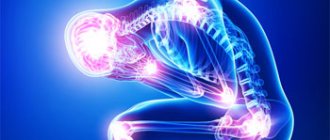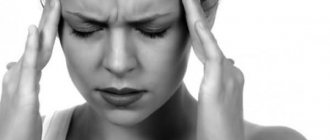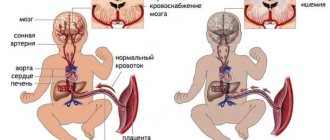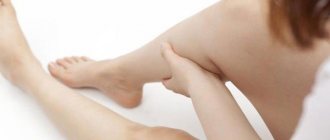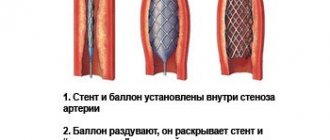Home » Articles from an expert » Vessels
Many people, when they hear the diagnosis of NCD, do not know what it is. Neurocirculatory dystonia is more often called vegetative-vascular dystonia, autonomic dysfunction syndrome or vegetative neurosis. This is a symptom complex that includes a large number of different syndromes with different etiologies. The main cause is dysfunction of the autonomic nervous system.
Reasons for NDC
The autonomic part of the nervous system regulates most phenomena and processes in the body. The main goal is to regulate the functioning of various organs. It is thanks to the autonomic nervous system that the organs coordinate their work with each other and quickly adapt to the needs of the whole organism.
The sympathetic division of the autonomic nervous system is neurons that are located in the lumbar and thoracic regions of the spinal cord. They are responsible for the following organs and systems:
- eyes (pupil dilation, lacrimation, shine);
- skin and the process of heat regulation (skin tone, sweat production, temperature, tolerance of heat and cold, sebum secretion);
- heart and blood vessels (regulate blood pressure, frequency of contractions of the heart muscle);
- respiratory organs (frequency, muscles, volume);
- digestive tract (components of saliva, its secretion, stomach acidity, intestinal motility);
- urinary and reproductive systems (erection, emptying the bladder).
In addition, this part of the neurons is responsible for sleep (its quality, falling asleep and waking up) and some personality characteristics (emotions, physical and mental activity).
The parasympathetic nervous system is also part of the autonomic division. This part of the neurons is interconnected with the sympathetic ones. They work together, but have the opposite effect. Neurons of the parasympathetic division are located in the sacrum and in the central part of the nervous system.
The concept of “dystonia” indicates that in the human body there is no balance in the work of the sympathetic and parasympathetic departments. There are many factors that can trigger this disease.
The main causes of neurocirculatory changes are:
- Genetic predisposition.
- Frequent and severe stress. Under the influence of severe stress, even a relatively healthy person can develop NCD.
- A sharp change in climatic conditions.
- Pathologies of a physical and neurological nature.
- Sudden changes in hormonal levels. In this case, menopause and puberty are taken into account. Hormonal imbalances can be associated with various diseases.
- Mental illnesses. It is necessary to take into account depression, panic attacks, and hypochondriacal disorders.
Possible complications
The danger of the pathology is that parents do not always take the symptoms of cerebrastia seriously, attributing them to age-related characteristics or the complex nature of the baby.
Without proper treatment, serious complications develop.
Children later begin to walk and talk, and their fine motor skills are poorly developed.
At school they cannot master the educational program and lag significantly behind their peers. Sometimes you have to resort to home schooling.
Mental disorders are often present: depression, phobia, nightmares, hallucinations.
Symptoms of NCD
Symptoms of NCD vary from patient to patient. The following main syndromes are distinguished:
- Cardiac dysfunction syndrome.
This syndrome is considered the most common. Usually a person experiences minor pain in the heart area. There are interruptions in its work, blood pressure changes. Symptoms appear when a person experiences stress, anxiety or extreme fatigue (both physical and mental).
The severity of such symptoms varies from person to person. They can be both moderate and very strong. The painful sensations are stabbing, cutting, aching or pressing in nature. Sometimes the pain syndrome is similar to myocardial infarction or angina.
In addition, with neurocirculatory dystonia, blood pressure changes. It can rise sharply and then fall just as quickly. Part of the system affects receptors in blood vessels, causing spasms. This condition is called a vegetative crisis. Its appearance is explained by a sharp activation of the sympathetic nervous system. This phenomenon is short-lived.
Quite often, a person’s sweat intensity increases, making it sticky and cold. This condition is called vegetative hyperhidrosis. Sweat glands are also regulated by the sympathetic part of the nervous system; its activation provokes an increase in the intensity of sweat production.
- Respiratory syndrome.
With this syndrome, a person experiences increased breathing, but at the same time it becomes superficial. A person suffers from lack of oxygen. These signs appear when the patient experiences severe anxiety. If the patient has a hysterical type, then the condition may worsen, even to the point of suffocation and a feeling of a lump in the throat. If a person has a milder form of the disease, then only slight discomfort is felt. Sometimes inhalations appear in the form of convulsions. The patient constantly feels a lack of oxygen, so he constantly opens the windows.
- Asthenic syndrome.
This syndrome manifests itself in the form of exhaustion, both emotional and physical. Almost all patients with neurocirculatory dystonia experience such a syndrome. There is a feeling of weakness and lethargy. Productivity decreases sharply, a person quickly gets tired even with minor loads. Due to constant fatigue, a person is in a bad mood.
Patients in childhood and adolescence develop problems with intellectual functions. Their performance begins to decline. This does not happen due to any lesions in the brain tissue, but due to the fact that the child cannot concentrate his attention on something - he becomes absent-minded. This manifests itself as nervousness, irritability, and short temper. He does not tolerate any load well.
- Thermoregulation disorders.
The diagnosis of NCD may also include problems with body thermoregulation. The nature of this syndrome depends on the type of dystonia. If the influence of the sympathetic part of the nervous system predominates, then the patient can tolerate cold normally, but it is difficult for him to tolerate heat and heat. In this case, he always has cold hands and feet, but his skin is not damp.
If the patient, on the contrary, has a predominant parasympathetic tone, then he does not tolerate cold well, but copes satisfactorily with heat. In this case, the hands are always very warm, but damp. In addition, sebum is produced abundantly. Such people try to dress warmly, but are constantly freezing.
Quite often, patients with problems with body thermoregulation experience low-grade body temperature - about 37ºC, but the figure can fluctuate between 36.7ºC and 37.1ºC. In this case, antibiotics, drugs with anti-inflammatory properties and other medications will not help.
- Fainting state.
This syndrome is typical for adolescence. And this applies to both girls and boys. Usually, fainting occurs after a person suddenly changes the position of the body in space. For example, when getting up from a sitting or lying position. This condition is called orthostatic hypotension. It is explained by the fact that blood flow through the vessels is redistributed slowly, especially in the legs. Because of this, blood pressure drops sharply, and the patient loses consciousness for a short period of time. In addition, this condition is observed with strong emotions, for example, if a person is scared.
Acute cerebral insufficiency syndrome (ACS) » Journal
Instrumental research methods are reduced to diagnosing the disease that constitutes the genesis of DEP and searching for characteristic morphological changes. The scope of diagnostic measures is determined by the severity of ischemic damage, clinical symptoms of the disease and the stages of the pathological process. The main methods for diagnosing disorders of the blood supply to the brain are:
- neuroimaging (CT and MRI);
- reencephalography;
- echoencephaloscopy;
- electroencephalography;
- Doppler ultrasound of head and neck vessels;
- coagulogram;
- blood chemistry;
- daily monitoring of ECG and blood pressure levels;
- neuropsychological testing.
The preferred method for detecting dyscirculatory encephalopathy is MRI. Compared to CT, changes characteristic of cerebral ischemia are more clearly visualized with MR diagnostics.
To clarify the level of cerebral blood flow, perfusion computed tomography is used, for which an intravenous bolus injection of a contrast agent is performed and scanning is carried out at the required levels.
Complex treatment of dyscirculatory encephalopathy should include an impact on the disease against which a chronic ischemic process has formed, and the elimination of neurological deficits with the activation of cerebral blood flow and the regulation of neurometabolic processes. Encephalopathy of complex origin and advanced cases of the disease are the most difficult to treat.
The main medications included in the treatment standards for DEP are:
- antihypertensive drugs;
- statins;
- anticoagulants and antithromboxants;
- hypoglycemic drugs;
- antioxidants;
- analgesics;
- nootropics;
- vasoactive agents;
- anticonvulsants;
- antiparkinsonian drugs.
In addition, physiotherapeutic measures, therapeutic exercises, and psychotherapy are effectively used in the treatment of encephalopathy.
DEP grades 2 and 1 are most effectively treated. It is at these stages that, with the help of therapeutic measures, it is possible to slow down the progression of the disease and neutralize its symptoms.
The condition of patients with stage 3 DEP is practically impossible to manage, especially if the disease is accompanied by developed dementia. Drug therapy for this category involves only the use of symptomatic drugs.
And the main help comes down to caring for and creating optimal conditions for their stay in society.
Cerebrovascular diseases are one of the most common neurological disorders. Impairment of cerebral blood flow is an inevitable process of brain aging.
However, at present, due to psycho-emotional and information overload, this pathology can develop even in relatively young people, reducing their quality of life and prematurely leading to disability.
The prognosis of the disease directly depends on the timeliness and adequacy of treatment
It is important to remember that cerebral dyscirculation is not a death sentence. With early detection of the disease, the progression of the ischemic process can be slowed down and the functional usefulness of nerve cells can be preserved
Rate this article:
Total: 46
Diagnosis of CVD
Primary diagnosis is carried out by a neurologist and includes:
- thorough examination of complaints, medical history and life history
- assessment and analysis of symptoms, including those preceding the disease
- full neurological examination
According to indications, additional examination methods are prescribed:
- laboratory research
- ultrasound examinations, including duplex and triplex scanning of blood vessels with Dopplerography
- functional, incl. 24-hour blood pressure monitoring and ECG
- X-ray
- MRI and CT of the brain
”alt=””>
According to indications, a consultation with other medical specialists is prescribed, including a cardiologist, endocrinologist, therapist, nephrologist, psychotherapist, etc.
Cerebrovascular syndrome can only be detected during diagnosis in a medical facility. Even if there is a suspicion of such a disease, neither the patient himself nor his relatives will be able to determine the pathology at home. Therefore, you should find a good vascular surgeon who can recognize the type of disorder and prescribe treatment.
The diagnosis of CVD can be made after the following diagnostic measures:
- Blood tests (prothrombin index, biochemistry) and urine tests.
- Tests for infections (syphilis).
- EEG.
- ECG.
- Chest X-ray.
- Angioscanning is a very informative method for identifying cerebrovascular insufficiency.
- Scintigraphy.
- Angiography.
- Transcranial Dopplerography.
- MRI.
Problems may arise in deciphering cerebrovascular disease, but choosing a qualified specialist will allow you to quickly determine the type of disease and develop treatment.
Discirculatory encephalopathy 2nd degree
Discirculatory encephalopathy of the 2nd degree of decompensation is a vascular lesion of the brain due to an acute failure in cerebral circulation. The main reason is the gradual reduction of blood vessels. The disease occurs as a result of hypoxia of certain areas of the brain. There is congenital and acquired encephalopathy.
Stage 2 discirculatory encephalopathy develops from a constant lack of blood supply and oxygen starvation of the brain. Some diseases can cause a decrease in the diameter of blood vessels.
Source: https://MedBur.ru/sosudy/sindrom-cerebralnoj-nedostatochnosti.html
Neurotic disorders
According to statistics, every second patient with neurocirculatory dystonia has neurotic disorders. For example, this applies to depression or anxiety. With an anxiety disorder, the patient periodically experiences panic attacks, which are accompanied by a strong feeling of fear. The patient is very worried for various reasons. For example, he is afraid of suffocating, dying, or not waking up. If such attacks are repeated frequently, this indicates that an anxiety disorder is developing. At the same time, patients are very restless and suspicious. They sleep poorly and often wake up for no reason. They find it very difficult to sleep.
Every fourth patient with neurocirculatory dystonia suffers from depression. She can be both hypochondriacal and anxious. Mood worsens or may change dramatically throughout the day.
If a patient has a hypochondriacal disorder, then he is constantly busy with his own health. He always worries about what the outcome of this or that illness will be. Typically, people with such disorders try to visit the hospital more often. They constantly complain to doctors, each time finding new symptoms. They have a tendency to constantly measure pulse, blood pressure, and body temperature. Such patients also always try to find new methods of treatment.
Etiology
Currently, scientists do not know the reasons for the development of pathology. It has been established that the neurologist’s diagnosis of “RCON” is a disease that is detected in newborns in 90% of cases. Doctors consider it as a residual manifestation of central nervous system damage.
Provoking factors for the development of pathology are the following conditions:
- First pregnancy after 40 years.
- During pregnancy, the expectant mother suffered an infectious disease. The baby is especially vulnerable in the first trimester.
- Permanent residence in a region with unfavorable environmental conditions.
- Frequently a pregnant woman is in a state of stress.
- Depression.
- During gestation, the woman subjected her body to high-intensity physical activity.
- Premature onset of the delivery process.
- The woman tried to terminate the pregnancy on her own.
- Tobacco smoking, consumption of alcoholic beverages and drugs during pregnancy.
- Placental abruption.
- Birth injuries.
- Immunological incompatibility of mother and child.
Only a neurologist can identify the disease. The diagnosis of “RCON” in children requires immediate medical intervention. Ignoring pathology leads to its progression and, accordingly, to negative health consequences.
In adults, manifestations of the disease are rarely detected. The main trigger for the development of the disease is injuries received in early childhood. Moreover, the consequences are long-term. The symptoms are most pronounced in people who abuse alcohol-containing drinks.
Most often, pathology is discovered randomly during a routine medical examination and in young people when passing a military medical commission. A diagnosis by a neurologist at RCSON is not a contraindication to service or work activity. The exception is cases of severe neuropsychiatric disorders.
View gallery
Drug therapy for NCD
Treatment for NCD is usually aimed at stabilizing the emotional background. It is important to pay more attention to the mental status of the patient. If his clinical picture is dominated by depressive disorders, then drugs from the group of antidepressants are prescribed. If he is constantly in a state of anxiety, medications that have anti-anxiety properties are prescribed.
In addition, it is necessary to eliminate signs of the disease. If the patient has arterial hypertension, then medications with an antihypertensive effect are used. If the patient suffers from insomnia, the doctor will prescribe sleeping pills. If a vegetative crisis develops, the doctor selects drugs from the group of ganglion blockers and stabilizers of blood vessel tone.
For neurocirculatory dystonia, the following medications are prescribed:
- Drugs with sedative properties.
- Antidepressants and drugs with anti-anxiety effect.
- Drugs that affect the heart and circulatory system.
The following drugs are commonly used:
- Novo-passit. A plant-based drug that has a calming effect and helps fight anxiety and fear.
- Persen. This medicine also helps to calm down and has a relaxing effect.
- Corvalol. After taking this drug, the person gradually calms down, and his sleep normalizes. Has a relaxing effect.
- Valocormid. It has antispasmodic, cardiotonic and relaxing properties. Gradually, the load on the heart muscle decreases. The excitability of the nervous system is adjusted.
- Normatens. This medicine is prescribed for hypertension. It dilates blood vessels, reduces the overall resistance of vessels that are located on the periphery. A person's sleep becomes deeper.
- Vinpocetine. Thanks to this medication, blood circulation in the brain improves. The medicine has vasodilating properties.
- Seduxen. This drug belongs to the group of tranquilizers. It inhibits the processes that occur in the brain.
- Azafen. Thanks to this drug, anxiety gradually disappears, the patient’s mood improves, and sadness goes away.
Participation of parents in the treatment of the child
A child with RCN must constantly feel support from his parents, otherwise the correction process will be incomplete.
Parents must organize a clear daily routine for the child and monitor its compliance. Strict adherence to the rules will lead the nervous, endocrine and immune systems to a state of stability. The transition to such a regime should be gradual, not abrupt.
Parents should also strive to ensure that the child expands his social circle. For this purpose, he can be enrolled in a sports section or some club. This way you can achieve two goals at once: integrate the child into the team and give him the opportunity to develop his talents. When choosing an activity, it is necessary to take into account the wishes and interests of the child.
Cerebral insufficiency, although it occurs due to disorders of the nervous system, is not a death sentence for the child. He will be quite capable of studying, communicating, making a career and starting a family in the future. The only condition for this is timely treatment and the deep involvement of parents in this process.
>Residual cerebral organic failure (RCON or RCI). What kind of diagnosis is this and how can it be dangerous for a child?
Auxiliary treatment
There are many additional techniques that are also used to treat dystonia.
- Spa treatment.
Sanatorium
If you have neurocirculatory dystonia, it is not recommended to travel a long distance from your place of residence. If you change the time zone by 3 hours, the patient’s condition may worsen, stress will appear, and the illness will worsen.
Usually balneological, climatic and mud resorts are prescribed. It is best to visit places in coastal areas and mountainous areas. Aerotherapy (exposure to fresh air on the human body), heliotherapy (sunbathing), speleotherapy (visiting salt mines, grottoes, karst caves, mines), thalassotherapy (using seafood, water and algae) are very useful. Contrast mineral baths, nitrogen, oxygen, pine baths, showers (Charcot, underwater, fan and others) are considered useful. Mud baths, applications, wraps, parallel exposure to electrophoresis and mud are required.
- Massage.
The type of massage is selected depending on the type of illness. For example, if the patient has a hypertensive type, then a general and acupressure massage of the legs, abdomen, and neck is performed. All striking techniques are excluded. Rubbing, stroking, kneading the skin is recommended. Vibration is allowed. Massage helps normalize the functioning of the nervous system, relieve headaches, and improve sleep.
- Reflexology.
With the help of special needles, laser equipment, electrical impulses and a magnetic field, it is possible to influence special points on the human body, which are located on the skin. This stimulation of certain areas has a good effect on the functioning of the nervous system. It is recommended to combine reflexology with other treatment methods.
- Psychotherapy.
Typically, somatic disorders in the human body are associated with emotional disorders. In this case, spa treatment will not give the desired result. Consultation with a psychotherapist or psychologist is necessary. These specialists will help you overcome fears, nervous disorders, and develop resistance to stressful situations. Gradually, the attitude towards negativity will change. It is necessary to master breathing control and relaxation techniques. This will help you control your emotions in the future.
- Exercise therapy.
Therapeutic exercise
Therapeutic exercise is another method that will help cope with neurocirculatory dystonia, but it must be used in combination with other methods. The doctor will select special exercises that will strengthen the human body and increase its resistance to adverse factors. In addition, breathing and blood pressure will stabilize, the emotional background and blood flow will improve.
It is recommended to skate, ski and swim. Aerobics in water and walking in the fresh air are very beneficial. It is not recommended to do high jumps, somersaults, somersaults, or engage in martial arts, bodybuilding and strength gymnastics. All classes should begin with minimal loads, and then gradually increase them.
- Nutrition.
Diet also plays an important role in the treatment of neurocirculatory dystonia. Nutrition should be balanced. It is recommended to include in your diet foods and dishes that are rich in vitamins. This will help the body fight disease. You definitely need to eat more cereals (especially oatmeal and buckwheat), fresh fruits and vegetables, dairy products, fish and seafood. The amount of spices and salt should be minimal. It is necessary to exclude fatty meat and animal fats.
Physiotherapy
Neurocirculatory dystonia can also be treated with physiotherapeutic procedures. The action of this treatment method is aimed at regulating the tone of blood vessels.
In addition, it is necessary to stabilize the metabolism and eliminate pain. Therapy must be intensive and systematic. All procedures and course duration are selected by the doctor.
Physiotherapeutic procedures have the following effects:
Physiotherapeutic procedures
- Calming - for example, this applies to aeroion therapy, electrosleep, electrophoresis (additionally, agents with sedative properties are used).
- Dilatation of blood vessels - this applies to local darsonvalization and galvanization.
- Constriction of blood vessels - these include electrophoresis with adrenaline and other drugs that affect adrenergic receptors.
- Tonic. For example, inductothermy, laser and magnetic techniques are prescribed.
- Antiarrhythmic. Electrophoresis using lidocaine and potassium chloride is usually used.
For the treatment of neurocirculatory dystonia, the following procedures are prescribed:
- Electrosleep. Therapeutic sleep under the influence of a special electrical impulse on the human brain. The session is carried out daily or with a break of a day. The course includes approximately 14 procedures.
- Electrophoresis. This is a method in which beneficial substances are introduced through the mucous membranes and skin. This involves current. A special cloth soaked in the medicine is placed on the body. Cover with another layer for protection, then fix the electrodes. The drugs are used depending on the form of neurocirculatory dystonia. For example, for the hypertensive type, a solution of aminophylline, sodium, magnesium sulfate, potassium bromide, dibazol, papaverine is used. For hypotensive use caffeine. If a person has a cardiac type, then a novocaine solution is used.
- Aeroionotherapy. During this procedure, the patient breathes air that contains negative ions.
- Inductothermy. During the procedure, the influence of heat is taken into account.
- Magnetic therapy. The patient's body is affected by a magnetic field.
- Laser therapy. The patient is exposed to a light beam.
- Galvanization. In this procedure, a person is exposed to a direct electric current.
- Darsonvalization. This is a procedure in which specific areas of the body are exposed to an alternating current pulse of low frequency and strength, but high voltage. Usually 6-10 procedures are enough.
Contraindications must be taken into account. These include:
- tuberculosis;
- mental illness;
- malignant tumors;
- epilepsy;
- diseases of the heart and circulatory system;
- blood diseases;
- hypertension (third stage);
- cerebral atherosclerosis;
- elevated body temperature (above 38º C).
Diagnosis of deviation and modern treatment
Diagnostic examinations of a child with suspected cerebral insufficiency should be aimed at determining the nature and etiology of the abnormality.
In this case, the following clinical research methods are used:
- Electroencephalography of the brain . This is a sensitive method for studying the functioning of the brain based on the study of electrical impulses that emanate from individual areas of the brain. The procedure is characterized by an almost complete absence of contraindications.
- Echoencephalography . The brain is examined using sound waves that are reflected from the surfaces of the meninges, skull bones, and soft coverings of the head. Thanks to this procedure, it is possible to identify pathological changes or processes in the structure of the brain.
- Rheoencephalography of cerebral vessels . The procedure allows you to assess the state of blood circulation and the quality of blood flow through the main vessels.
Of course, in addition to the listed diagnostic methods, the child needs to be examined by an experienced neurologist.
Once the diagnosis is determined, the specialist will prescribe adequate treatment. Its complex includes the following events:
- Drug therapy . In this case, it is indicated to take amino acids (in particular, glycine, lecithin, folic and glutamic acids), hepatoprotectors, antispasmodics, as well as indirect antihypoxants - substances that help saturate the body with oxygen and reduce the need for it. In addition, in case of RCN, nootropic drugs are taken, which have a neurotrophic and neuroprotective effect directly on the central nervous system. Thanks to this, tissue metabolic processes are normalized.
- Vitamin therapy . Particular emphasis is placed on vitamins B6 and B11.
- Transcranial micropolarization . This procedure has a therapeutic effect on the nerve cells of the brain. This happens due to the use of direct current of minimal strength. The benefit of the procedure is that the development of nervous tissue is stimulated and new connections between cells are created. When performing transcranial micropolarization, a special cap with wires is put on the child’s head. The procedure does not cause any discomfort;
- Therapeutic massage , the technique of which is suitable for correcting disorders of the central nervous system. It helps improve blood circulation, strengthens muscles, helps restore nerve tissue and generally improves the child’s vitality.
- Gentle manual therapy techniques . They improve the passage of nerve impulses, stimulate blood circulation, stabilize the patient’s emotional state and help eliminate the effects of stress. The required therapy program is determined by a specialist.
- Also, for medicinal purposes, the child may be recommended swimming .
Traditional medicine recipes
For high blood pressure, you can use the following plants:
- mint;
- barberry;
- viburnum;
- chokeberry;
- valerian;
- magnolia;
- hawthorn berries.
All these components will help the patient lower blood pressure and calm down. You can prepare a herbal mixture from the inflorescences of hawthorn, lily of the valley, valerian roots, mint and fennel. You can brew tea from blueberries, currants (exclusively black ones - both berries and leaves of the plant will do), barberry and chokeberry. All components can be used separately or mixed.
For low blood pressure, ginseng, eleutherococcus, nettle, dandelion, lemongrass, juniper, and St. John's wort are used. All these herbs improve the overall tone of the body and increase blood pressure. A mixture of hop cones with echinacea inflorescences, rhodiola roots, water and honey is also used for treatment. Another herbal mixture that includes nettle, blue blackberry and dandelion leaves is also very useful.
For the cardiac type of neurocirculatory dystonia, herbs are used that help normalize the functioning of the heart. It is necessary to use raisins, valerian, rosemary, rose hips, mint. A herbal mixture of St. John's wort, hawthorn, rosemary, hops, mint and valerian is suitable. You can use tea based on coltsfoot, raspberry leaves, hawthorn, valerian, and rose hips. A popular composition is based on dill, lita, mint and wormwood seeds. You can prepare a combination remedy from tincture of hawthorn, peony, valerian, eucalyptus, motherwort, cinnamon and mint.


